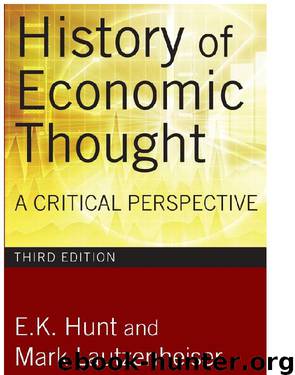History of Economic Thought by E. K. Hunt

Author:E. K. Hunt
Language: eng
Format: epub
Publisher: M.E. Sharpe
But these ifs must be rejected. First, the whole point of Walras’s general equilibrium analysis was to show that price changes in any one market affected supply and demand in innumerable other markets. Thus, as the two prices began to change, many other supply and demand curves would shift. The initial disequilibrium would spread to many markets. As these other prices began to change, nearly all supply and demand curves would begin to shift again. Thus, disequilibrium in two markets could rapidly become a disequilibrium in all markets. How then would equilibrium ever be established?
Walras escaped this dilemma by asserting that a given price change would have a primary effect only in the market of the affected commodity. Its effects on other markets would be secondary. He then asserted his faith that “these secondary effects, however, will be less appreciable than the primary effect if there are a great many commodities . . . on the market.”69
Subsequent disciples of Walras have shown that with all of Walras’s assumptions, if the secondary effects are sufficiently small, then the market will indeed automatically achieve an equilibrium. But they have never shown that these secondary effects must, in reality, be that small.
Furthermore, several of Walras’s other assumptions are also highly questionable. He assumed that because the economy was perfectly competitive, the small, relatively powerless business firms would always react to a situation of excess supply by lowering their prices. Experience has taught us, however, that large, powerful business firms that have some control over prices tend to reduce their level of output and attempt to maintain their price in the face of an excess supply that they view as temporary. This reduction in output reduces incomes, which further reduces demand for other products. If these producers react to the resultant excess supply in their market by reducing output, then a general glut, economic crisis, or depression would seem to be the only possible result.
Moreover, Walras assumed that all exchangers would react to any set of prices as if they expected those prices to be the equilibrium prices that would continue to prevail. Again, experience shows that exchangers frequently behave otherwise, exchanging on the basis of prices that they expect to obtain in the future. John Maynard Keynes showed, as we will see in a later chapter, that these expectations can frequently make the achievement of a full-employment general equilibrium impossible.
We can conclude that Walras’s belief that the market would automatically create a full-employment general equilibrium was as much a matter of pure faith as had been Say’s belief—and both beliefs were equally unjustifiable on either theoretical or empirical grounds.
Download
This site does not store any files on its server. We only index and link to content provided by other sites. Please contact the content providers to delete copyright contents if any and email us, we'll remove relevant links or contents immediately.
International Integration of the Brazilian Economy by Elias C. Grivoyannis(90842)
The Radium Girls by Kate Moore(11921)
Turbulence by E. J. Noyes(7935)
Nudge - Improving Decisions about Health, Wealth, and Happiness by Thaler Sunstein(7615)
The Black Swan by Nassim Nicholas Taleb(7010)
Rich Dad Poor Dad by Robert T. Kiyosaki(6399)
Pioneering Portfolio Management by David F. Swensen(6226)
Man-made Catastrophes and Risk Information Concealment by Dmitry Chernov & Didier Sornette(5921)
Zero to One by Peter Thiel(5685)
Secrecy World by Jake Bernstein(4643)
Millionaire: The Philanderer, Gambler, and Duelist Who Invented Modern Finance by Janet Gleeson(4374)
The Age of Surveillance Capitalism by Shoshana Zuboff(4209)
Skin in the Game by Nassim Nicholas Taleb(4161)
Bullshit Jobs by David Graeber(4094)
The Money Culture by Michael Lewis(4076)
Skin in the Game: Hidden Asymmetries in Daily Life by Nassim Nicholas Taleb(3929)
The Dhandho Investor by Mohnish Pabrai(3698)
The Wisdom of Finance by Mihir Desai(3650)
Blockchain Basics by Daniel Drescher(3507)
